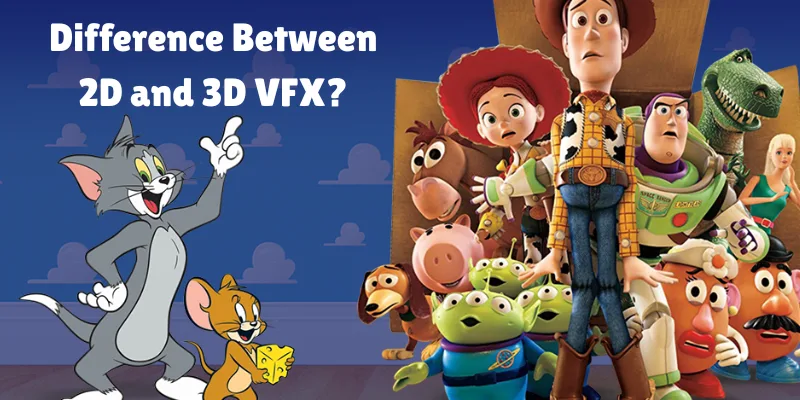
Visual effects (VFX) play an important role in film, animation, and gaming, bringing imagination to life on screen. While both 2D and 3D VFX enhance visual storytelling, they differ in technique, tools, and application. VFX Courses in Chennai offer hands-on training to help learners understand these differences. Understanding the key differences between the two can help artists, filmmakers, and enthusiasts choose the right approach for their creative projects.
What is 2D VFX?
2D VFX refers to visual effects created in two dimensions—height and width—without depth. These effects are typically applied to flat images, video footage, or hand-drawn elements. Common examples of 2D VFX include:
- Smoke or fire overlays
- Lightning effects
- Motion graphics and titles
- Rotoscoping (cutting elements out of a scene)
- Compositing layers together
These effects are typically created using software such as Adobe After Effects, Nuke, or Fusion. An Animation Course in Chennai can help you gain the skills to work effectively with these tools. Because they work on flat footage, 2D VFX is often used in post-production to enhance live-action scenes or animated 2D content.
What is 3D VFX?
3D VFX, on the other hand, involves the use of three-dimensional space—height, width, and depth. Artists use 3D modeling, animation, and rendering to create objects and environments that can move and interact with real or virtual cameras. To enhance your post-production knowledge, it’s also helpful to explore the Top 5 Video Editing Types. Some common 3D VFX examples include:
- Creatures and characters (like dragons or aliens)
- Digital doubles
- Environments and landscapes
- Explosions, destruction, or large-scale simulations
- Vehicles and machinery
3D effects are created using software like Autodesk Maya, Blender, Cinema 4D, or Houdini. A Video Editing Course in Chennai can complement these skills by teaching how to seamlessly integrate 3D elements into final footage. These tools enable complex lighting, texture, and physics simulations, creating hyper-realistic scenes.
Key Differences Between 2D and 3D VFX
Let’s break down the core differences:
1. Dimension and Depth
- 2D VFX deals with flat visuals; there’s no true depth involved.
- 3D VFX creates the illusion of depth and perspective, simulating a real-world environment.
2. Tools and Software
- 2D relies on compositing and editing tools such as After Effects or Nuke.
- 3D requires modeling and animation platforms like Blender, Maya, or Houdini.
3. Time and Complexity
- 2D effects are generally quicker to produce and are often used for simpler scenes.
- 3D effects can be time-consuming and resource-intensive, requiring careful planning and rendering.
4. Applications
- 2D VFX is often used in TV shows, commercials, or stylised animations.
- 3D VFX is used for blockbuster films, games, and projects requiring realistic simulations.
5. Integration
- 2D is usually integrated on top of or behind existing footage.
- 3D needs to be carefully tracked and matched with camera movements and lighting.
When to Use 2D vs 3D VFX?
Choosing between 2D and 3D VFX depends on the project’s needs, budget, and artistic vision. For instance:
- Use 2D VFX when you need to enhance existing footage with energy bursts, text animations, or smoke. It’s also ideal for stylised animations or where time constraints are a factor.
- Use 3D VFX when you’re creating complex environments, characters, or need realism, especially in fantasy, sci-fi, or action-heavy projects. Discover the benefits using of VFX in enhancing visuals and storytelling impact.
In many cases, both 2D and 3D VFX are combined to produce the final look. For example, a 3D creature might be composited into live-action footage using 2D techniques like colour correction, lighting adjustments, and rotoscoping.
Examples in Film
Let’s look at a few examples:
- 2D VFX Example: The TV show Stranger Things uses 2D effects for glitchy overlays and title sequences.
- 3D VFX Example: In Avengers: Endgame, most battle sequences were filled with 3D assets like characters, portals, and environments.
In most major productions, a hybrid approach is used where artists blend 2D compositing with 3D elements. The Best Training Institute in Chennai can help you master these advanced VFX techniques.
While 2D and 3D VFX differ in their approach, both serve the same purpose—enhancing storytelling through compelling visuals. Each technique has its strengths and ideal use cases, and often, the most impactful scenes are created when the two are used together. As the technology evolves, the line between 2D and 3D continues to blur, giving artists more tools than ever to bring their imagination to life.